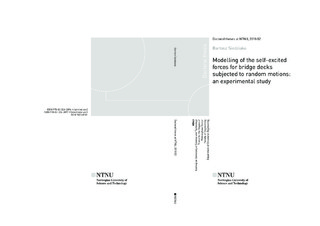| dc.description.abstract | This thesis concerns the dynamic behaviour and analysis of long-span bridges subjected to wind loading and, in particular, the modelling of self-excited forces based on wind tunnel measurements.
The goal of this PhD study was to increase the knowledge of wind-induced forces acting on a bridge deck, examine and improve wind tunnel testing techniques and validate the currently applied load models in bridge aerodynamics. This experimental work is based on wind tunnel testing of bridge decks setup with a use of a forced vibration technique and comparing experimental results with numerical predictions.
The work completed during this PhD covers to a large extend the process of assembly and preparation of the experimental setup that is capable of measuring wind-induced forces under motions that resemble actual bridge vibrations for wind tunnel testing. Therefore, although PhD candidate did not assist in preliminary works and design of the forced vibration rig, this thesis still concerns related activities such as software development for the motion control and data acquisition, wind tunnel preparatory works as well as section model building.
Described in this thesis experimental setup for section models utilizes the advantages of the forced vibration technique while simultaneously overcoming its weakness, which is simplified motion that is different from vibrations that the bridge will encounter in natural wind. The novelty of this the experimental setup lies in the capability of forcing complex motion patterns during wind tunnel experiments. The section model is no longer restricted to harmonic oscillations but can vibrate arbitrarily, simultaneously utilizing horizontal, vertical and torsional axes of motion. This allowed a spectrum of new types of wind tunnel tests to be executed in this study with the use of bridge deck section models. This study made it possible to examine, for example, the self-excited forces induced under narrow-banded and broad-banded motions as well as flutter and realistic bridge oscillations. Moreover, the system developed herein has a potential to serve as a tool to provide more sophisticated nonlinear load models for self-excited forces that are able to accurately predict wind-induced loads under realistic bridge motions for more complicated bridge cross-section geometries.
The data recorded during the performed wind tunnel tests were used to investigate several assumptions regarding commonly applied load models for self-excited forces and wind tunnel testing techniques and to develop an enhanced procedure for the identification of the aeroelastic properties of the bridge decks. In addition, the experimental data obtained with the use of a forced vibration technique are characterized by very low variability. Therefore, as demonstrated in this study, lowering the uncertainties of the wind tunnel data makes predictions of the critical flutter speed and buffering response more reliable. | nb_NO |
